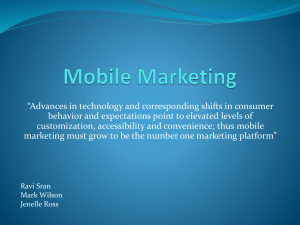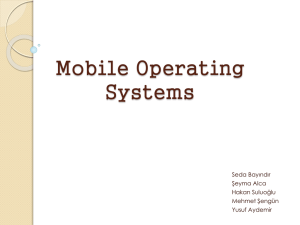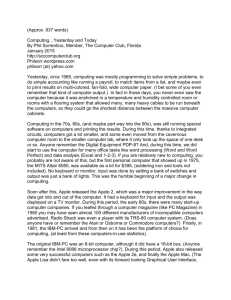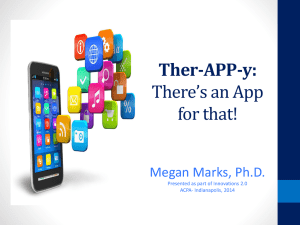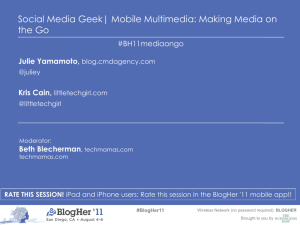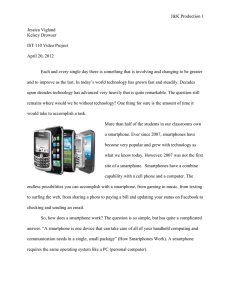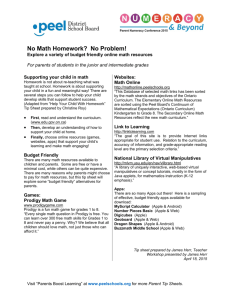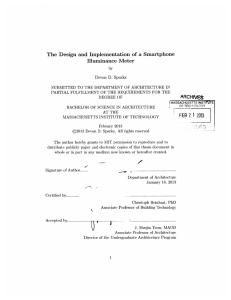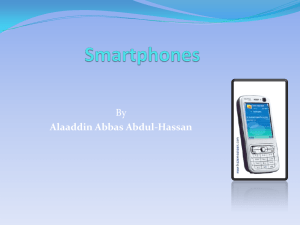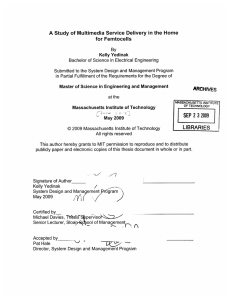Mobile Computing and Commerce
advertisement
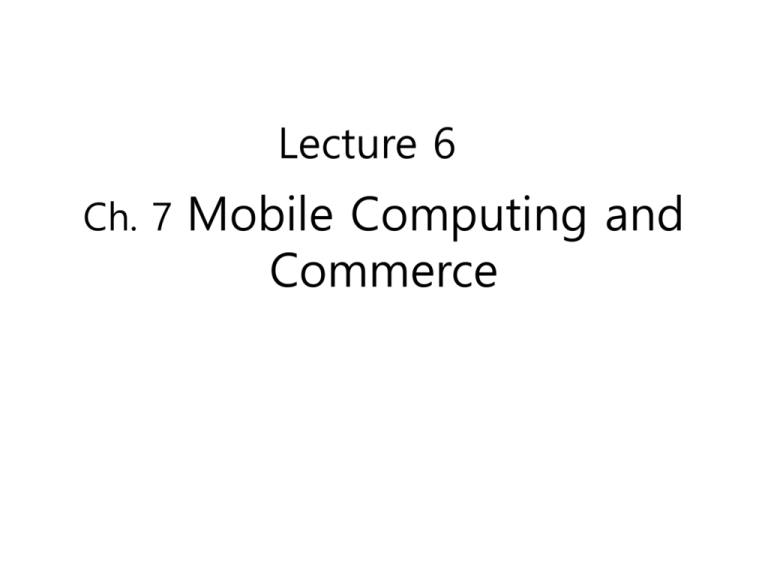
Lecture 6 Ch. 7 Mobile Computing and Commerce 7.1 Mobile Computing Technology • The mobile computing landscape has evolved rapidly over the last two decades. • Wireless technology makes location irrelevant-making mobile computing and commerce a source of vast opportunities for businesses • As of 2010, there are over 4.6 billion cell phone users globally, which accounts for 60.6% of the world population. 7-2 Convergence Of technologies to smartphone Predicted 20 years ago 3 Most popular mobile operating sy stems (OSs) Androids Supported and merged by google, #1 in the market iOS (Apple) #2in the market, Used in Apple’s iPhone, iPod Touch and iPad products Symbian OS (Symbian Foundation) Globally it’s the dominant smartphone OS; runs mainly on Nokia phones Blackberry OS (RIM) Dominant smartphone OS in U.S. Windows Mobile OS (MS) Losing ground globally to newer platforms Windows Mobile OS (Google/Open Handset Alliance) Predicted to compete fiercely against Apple’s iOS Palm OS (Palm) Enhanced for use in smartphones and PDAs Linux OS (Linux) iOS, Android & Palm OSs are based on Linux Kernel 7-4 Android Android is an operating system based on the Linux kernel, and designed primarily for touchscreen mobile devices such as smartphones and tablet computers. Initially developed by Android, Inc., which Google backed financially and later bought in 2005. Android's source code is released by Google under the Apache License. This permissive licensing allows the software to be freely modified and distributed by device manufacturers, wireless carriers and enthusiast developers. Figure 7.6 Global Smartphone OS Market Share year 2010 1% Research in Motion 20% Apple iOS 47% MS Windows Mobile Android OS 14% Linux Symbian 9% 5% Other OS 4% Source: Adapted from Gartner, 2010 7-6 Year 2012 Year 2012 Figure 7.6 Global Smartphone OS Market Share 7-8 7.2 Mobile Financial Services (MFS ) • Mobile banking is an extension of online banking • Financial service handhelds use short codes for sendin g SMS texts. Once a company has leased its short cod e, it can use it in promotions and interactivity with cust omers – Voting on the TV show American Idol is done with short code s. Each contestant is assigned a short code; & viewers send text messages indicating which performer they liked best. In Europe, U.S., & Asia, an increasing percent of banks offer mobile access to financial and account information 7-9 Mobile Electronic Payment Systems & examples Innovative e-payment systems are needed that make transactions fro m smartphones and other mobile devices convenient and secure – Charge to phone bill w/ SMS confirmation Boku.com – Near Field Communication (NFC) Blingnation.com – Credit card via phone # & SMS – Zong.com | Paypal.com – Credit card + Web form – Transfer funds from payment account using SMS obopay.com – Mobile phone card reader square.com – Using 2D tags Cimbal.com – Bumping iPhones with Payment Applications bumptechnologies .com – Phone displays barcode that retailers scan Facecash.com – Mobile wallet Most payment systems described above are illustrated on Youtube.c om 7-10 7.3 Mobile Shopping, Entertainment and Advertis ing Mobile commerce B2C handhelds are expanding in retail, entertainment, gaming, travel, hospitality service, and dig ital content—music, news, videos, movies, or games via p ortals Shopping from wireless devices – Wireless shoppers are supported by services similar t o those available for wired (wireline) shoppers – Customers use smartphones to shop at sites like targ et.com, amazon.com, and buy.com – Many national restaurant chains offer consumers the ability to search menus, order and pay for food via m obiles 7-11 Mobiles, Codes, and Comparison Sites • Consumers increasingly use mobiles to get p roduct & price info while shopping in traditi onal stores • Pricegrabber.com, slifter.com, and froogle.co m are a few of the price comparison sites to search for product information from mobile devices Figure 7.9 QR codes linked to specific goods/services give mobile users access to product info • Experts are now advising retailers that they n eed to take these savvy shoppers into consid eration when developing their mobile strateg y 7-12 Mobile Entertainment Sports enthusiasts enjoy a large number of apps and services on their mobile devices. – ESPN’s Sport Center, in partnership with Sanyo, offers a cell phone dedicated to sports. – Companies like theChanner.com and FLO TV offer television programming to mobiles – Fox Mobile introduced a mobile app that will allow smartphone users to view TV content from its Web site Hulu.com – iTunes Store continues to be a leader in making digital music, movies, & podcasts – Food Network has a handheld with tips and recipes for fine dining and entertaining 7-13 Mobile Game Market • >45% of smartphone users play games • With smartphones, the potential audience for mobile games is substantially larger than the market for other platforms, such as PlayStation or X-box • Mobile game market is growing rapidly as network speeds and the power of mobiles increase the richness of the gami ng experience • Ericsson, Motorola, Nokia, and Siemens established the Ope n Mobile Alliance openmobilealliance.org to define a range of technical standards that make it possible to deploy mobil e games across multi-game servers and wireless networks, a nd over different mobile devices 7-14 7.4 Location-Based Services and Commerce Location-based commerce (l-commerce)-- delivery of ads, products, or services to customers whose locations are known at a given time; also called location-based services (LBSs) 5 key concepts: 1. 2. 3. 4. 5. Location. Determining the position Navigation. Plotting a route Tracking. Monitoring movement along a route Mapping. Creating digital maps Timing. Determining the precise time at a specific location 7-15 IT at Work 7.4 NextBus: Superb Customer Service San Francisco bus riders carrying a mobile can quickly find out when a bus is likely to arrive at a bus stop. The NextBus system tracks public transportation buses in real time. Knowing where each bus is and factoring in traffic patterns and weather reports, NextBus dynamically calculates the ETA of the bus to each bus stop on the route. Figure 7.13 NextBus operational model 7-16 7.5 Mobile Enterprise Applications • Organizations are creating a full range of mobile apps—from back-office to consumer-centric apps • Leading organizations are building a marketing and sales strategy that ‘s built on connecting with their customers via mobiles • limitations due to 2-inch or 2-inch screens are being eliminated by the iPad and other mobile tablets—and expanding the possibilities of mobile computing and mobile enterprise applications. 7-17 Mobile enterprise apps Figure 7. 16 A Starbuck's branch in the Polanco district of Mexico City Mobile POS (Point of Sale) Inventory management Customer service Job dispatch Customer support and mobile CRM – sales force automation and field service • Mobile supply chain management (MSCM) • • • • • Figure 7.15 Starbucks Venti coffee 7-18 Diverse applications Location-based service Smart Phone Use Top apps http://www.youtube.com/watch?v=yC4cE7ksgfI App world .Apple store http://www.apple.com/kr/iphone/from-theapp-store/ .google app store http://www.google.com/intl/ko/enterprise/a pps/business/ .best apps http://blog.sktworld.co.kr/2892
